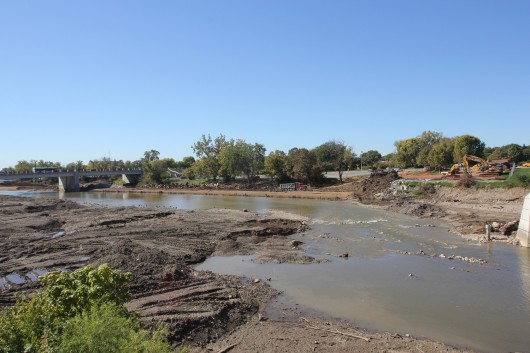
The Olentangy River renovation is set to be completed by the end of May.
Credit: Shelby Lum / Photo editor
The Olentangy River renovation, a project Ohio State supported with $2 million, is set to be completed by the end of May.
In August 2012, the project began with the partial removal of the Fifth Avenue Dam. About one-third of the structure was removed completely, while along the remaining length of the dam, the top two feet of concrete were removed and the rest was covered with soil, George Zonders, spokesman for Columbus Department of Public Utilities, said.
The project is estimated to be finished by May 31, weather permitting. Work will continue throughout the winter, including construction of the remaining planned wetland areas and some planting, with additional planting set to continue into the next spring, Zonders said.
The total cost was $6.9 million, which includes $500,000 in grant funding from the Ohio Environmental Protection Agency, $2 million from OSU and $2.1 million from the City of Columbus.
“We anticipate the project will meet the goals of re-establishing the natural flow of the Olentangy, which — with the addition of riffles and pools — will be beneficial to wildlife and plants while also providing some natural filtration of storm water through the new wetland areas,” Zonders said. “Subjectively speaking, we also believe it will be effective in improving the overall appearance of this section of the Olentangy more quickly than had we simply let the river flow and random plants begin to take root.”
The city decided to remove the dam as a supplemental environmental project in agreement with the Ohio EPA to enhance the water quality and habitat in the streams in a corridor of the Olentangy River, according to the Department of Public Utilities.
Alison Hinkle, a spokeswoman for OSU Administration and Planning, said the process of transforming the Olentangy is important to OSU.
“The restoration of the river is also a cornerstone of our One Ohio State Framework plan, which is the university’s long range plan,” Hinkle said in an email. “This river will yield a living-learning laboratory where teaching can and will thrive both during and long after the project is complete — a key recommendation of the Framework Plan.“
The restoration is meant as encouragement for students to learn not only through classrooms and books, but through the entire campus and environment, Hinkle said.
Zonders also said OSU’s partnership plays a huge part in the overall scheme of the project.
“OSU is a vital stakeholder in this project, as a large portion of the project area adjoins the campus,” Zonders said. “The $2 million in funding contributed by the university toward the project means more can be done now to improve both the short-term and long-term appearance of the entire area.”
Some students agreed the restoration of the river will help OSU.
“I think it will be very beneficial,” said Shelby Kerstetter, a first-year in business. “I think it not only benefits the environment but will benefit the students as well.”
Kerstetter said she thinks the restoration will lead to more hands-on research for students.
“It’s kind of expensive, but our university has a lot of money and can afford the construction,” Kerstetter said. “Helping out the students is a good way to spend the money.”


